
A rose is a woody perennial flowering plant of the genus Rosa, in the family Rosaceae, or the flower it bears. There are over three hundred species and tens of thousands of cultivars. They form a group of plants that can be erect shrubs, climbing, or trailing, with stems that are often armed with sharp prickles. Their flowers vary in size and shape and are usually large and showy, in colours ranging from white through yellows and reds. Most species are native to Asia, with smaller numbers native to Europe, North America, and northwestern Africa. Species, cultivars and hybrids are all widely grown for their beauty and often are fragrant. Roses have acquired cultural significance in many societies. Rose plants range in size from compact, miniature roses, to climbers that can reach seven meters in height. Different species hybridize easily, and this has been used in the development of the wide range of garden roses.

Passiflora edulis, commonly known as passion fruit, is a vine species of passion flower native to southern Brazil through Paraguay and northern Argentina. It is cultivated commercially in tropical and subtropical areas for its sweet, seedy fruit. The fruit is a pepo, a type of berry, round to oval, either yellow or dark purple at maturity, with a soft to firm, juicy interior filled with numerous seeds. The fruit is both eaten and juiced, the juice often added to other fruit juices to enhance aroma.

Ranunculus is a large genus of about 600 species of flowering plants in the family Ranunculaceae. Members of the genus are known as buttercups, spearworts and water crowfoots.

Cassia fistula, commonly known as golden shower, purging cassia, Indian laburnum, or pudding-pipe tree, is a flowering plant in the subfamily, Caesalpinioideae of the legume family, Fabaceae. The species is native to the Indian subcontinent and adjacent regions of Southeast Asia. It ranges from eastward throughout India to Myanmar and Thailand and south to Sri Lanka and southern Pakistan. It is a popular ornamental plant and is also used in herbal medicine. It is both the national tree and national flower of Thailand. It is the state flower of Kerala in India. It is the provincial flower of North Central Province in Sri Lanka.

Lamium galeobdolon, commonly known as yellow archangel, artillery plant, aluminium plant, or yellow weasel-snout, is a widespread wildflower in Europe, and has been introduced elsewhere as a garden plant. It displays the zygomorphic flower morphology, opposite leaves, and square stems typical of the mint family, Lamiaceae. The flowers are soft yellow and borne in axial clusters, with a prominent 'hood'. It spreads easily and so has been commonly used as an ornamental ground cover. It can be invasive in places where it is not native and caution must be taken when planting in these areas.

Vasant Panchami, also called Saraswati Puja in honor of the Hindu goddess Saraswati, is a festival that marks the preparation for the arrival of spring. The festival is celebrated by people of Dharmic religions in the Indian subcontinent and Nepal in different ways depending on the region. Vasant Panchami also marks the start of preparation for Holika and Holi, which take place forty days later. The Vasant Utsava (festival) on Panchami is celebrated forty days before spring, because any season's transition period is 40 days, and after that, the season comes into full bloom.
Banksia fasciculata is a species of column-shaped shrub that is endemic to Western Australia. It has hairy stems, crowded, prickly leaves, yellow flowers and hairy fruit.

Mimetes chrysanthus is an evergreen, upright shrub of 1½–2 m high that has been assigned to the family Proteaceae. It has green, slightly stalked oval leaves of 3–4½ cm (1.2–1.8 in) long and 1–1¾ cm (0.4–0.7 in) wide. The inflorescences are near the tip of the branches, cylinder-shaped and consist of 50–70 densely cropped flower heads, each in the axil of a green leaf, consisting of 25–35 golden yellow, faintly sweet scented flowers. It is endemic to the Fynbos ecoregion of South Africa and is found in two locations, in the Western Cape province. The flowering season is from March to May or June, but flower heads sometimes occur in any other part of the year.
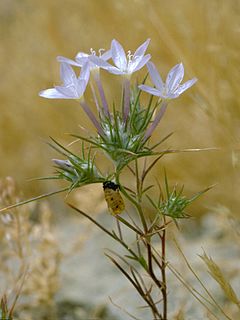
Eriastrum pluriflorum is a species of flowering plant in the phlox family known by the common names Tehachapi woollystar and many-flowered eriastrum.

Eriastrum sapphirinum is a species of flowering plant in the phlox family known by the common name sapphire woollystar. This wildflower is endemic to California where it is found in many habitats throughout the state. It is an annual reaching anywhere from 5 to 40 centimeters in height, forming clumps or singular spindly stems. The stem is erect and may be reddish to green, and has the occasional threadlike leaf with sparse hairs to a coat of dense wool. The inflorescences at the tips of the stems are packed with pointed, leaflike green to red bracts and funnel-shaped flowers. The corolla of the flower has five lobes each one half to one centimeter long and pale to bright blue. The throat of the flower is the same color or yellowish to white. At the mouth of the tube there may be dots of yellow and white. The light colored stamens protrude.
Eriastrum abramsii is a species of flowering plant in the phlox family known by the common name Abrams' woollystar. The epithet abramsii commemorates LeRoy Abrams. It is endemic to California, where it is known from the hills of the Coast Ranges in and around the San Francisco Bay Area. It is an annual herb producing a thin, usually woolly stem up to about 15 centimeters tall. The leaves are divided into several narrow, threadlike linear lobes. The inflorescence is a woolly cluster of narrow, leaflike bracts laced with webby fibers. The small flowers have yellow throats and white or blue corolla lobes.
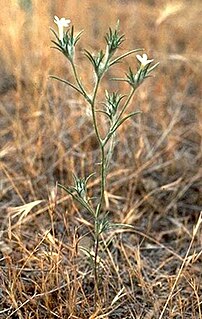
Eriastrum brandegeeae is a species of flowering plant in the phlox family known by the common name Brandegee's woollystar. It is endemic to California, where it is known from the chaparral and woodlands of the North Coast Ranges, generally on volcanic soils. There have been specimens collected from the San Francisco Bay Area which are closer to this species than other Eriastrum, but may actually be a new species. This is an annual herb producing a thin, usually woolly stem up to about 30 centimeters tall. The leaves are divided into several narrow, threadlike linear lobes. The inflorescence is a woolly cluster of narrow, leaflike bracts laced with webby fibers. The small flowers have white to light blue corollas.
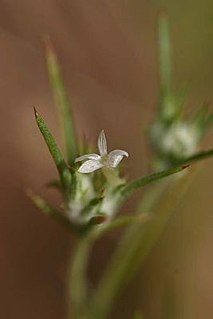
Eriastrum hooveri is a rare species of flowering plant in the phlox family known by the common name Hoover's woollystar. It is endemic to the South Coast Ranges of California from San Benito to Los Angeles Counties, where it grows in grassy open habitat. It is an annual herb producing a wiry, usually woolly stem up to about 15 centimeters tall. The leaves are linear and threadlike, less than three centimeters long, and sometimes divided into two thready lobes. The inflorescence is a woolly cluster of narrow, leaflike bracts laced with webby fibers. The flowers are white and just a few millimeters in length.
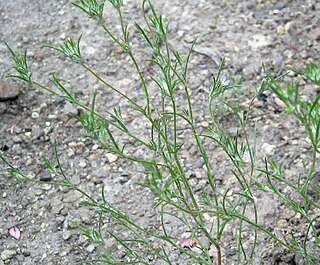
Eriastrum wilcoxii is a species of flowering plant in the phlox family known by the common name Wilcox's woollystar. It is native to the western United States, where it grows in various types of desert and plateau habitat. It is an annual herb producing a thin, branching, usually woolly stem up to about 30 centimeters tall. The leaves are narrow and thready, up to 3 centimeters long, and sometimes divided into two or more lobes. The inflorescence is a woolly cluster of narrow, leaflike bracts laced with webby fibers. The small flowers have yellow throats and blue corollas with lobes up to half a centimeter long.

Telopea truncata, commonly known as the Tasmanian waratah, is a plant in the family Proteaceae. It is endemic to Tasmania where it is found on moist acidic soils at altitudes of 600 to 1200 m (2000–4000 ft). Telopea truncata is a component of alpine eucalypt forest, rainforest and scrub communities. It grows as a multistemmed shrub to a height of 3 metres (10 ft), or occasionally as a small tree to 10 m (35 ft) high, with red flower heads, known as inflorescences, appearing over the Tasmanian summer and bearing 10 to 35 individual flowers. Yellow-flowered forms are occasionally seen, but do not form a population distinct from the rest of the species.
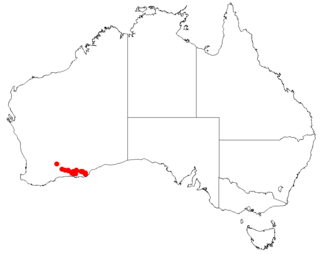
Persoonia cymbifolia is a species of flowering plant in the family Proteaceae and is endemic to the south of Western Australia. It is an erect, spreading shrub with smooth bark, hairy young branchlets, linear to narrow oblong leaves and yellow flowers borne singly or in groups of up to three on a short rachis.
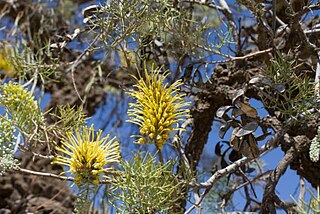
Hakea eyreana, commonly known as straggly corkbark, is a tree in the family Proteacea and is endemic to arid parts of inland Australia. It has needle-shaped leaves, greenish-yellow flowers and oblong to egg-shaped fruit.

Petrophile biternata is a species of flowering plant in the family Proteaceae and is endemic to southwestern Western Australia. It is a shrub with biternate or pinnate, sharply-pointed leaves, and oval or spherical heads of glabrous, sticky, yellow flowers.

Mimetes saxatilis or limestone pagoda is an evergreen, upright, rarely branching shrub of 1–2¼ m (3⅓–7¼ ft) high, assigned to the family Proteaceae. The approximately oval leaves are 3½–5 cm (1.4–2.0 in) long and 1½–3 cm (0.6–1.2 in) wide with a blunt, thickened, reddish tip or with three crowded teeth. It has cylinder-shaped inflorescences topped by a crest of green leaves, further consisting of heads with 12-22 individual bright yellow flowers, each in the axil of a flat, green leaf. It is an endemic species that is restricted to limestone outcrops in the Agulhas plains in the very south of the Western Cape province of South Africa. It is considered an endangered species. Flowering may occur between July and December, but is unreliable in its timing, dependent on sufficient moisture availability.
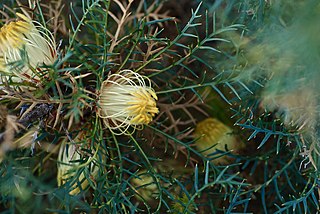
Banksia recurvistylis is a species of shrub that is endemic to a restricted area of Western Australia. It has densely crowded, deeply serrated pinnate leaves, the lobes very narrow triangular, and heads of between twenty-five and forty pale yellow flowers.


















